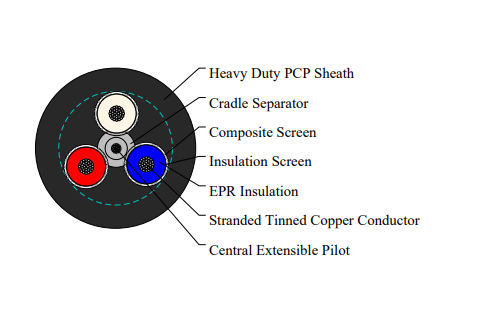Overheating Risks

Identifying Overheating Symptoms
Overheating in mining cables manifests in several telltale signs. Discolored or charred insulation, an acrid burning odor, and physically hot cables are immediate red flags. These symptoms indicate that the cables are operating beyond their thermal limits, risking insulation breakdown and potential fire hazards. Regular thermal imaging scans and monitoring can help in early detection, preventing severe consequences.
Causes of Overheating
Several factors contribute to the overheating of mining cables. Overloading circuits, inadequate ventilation, and high ambient temperatures are primary culprits. Additionally, improper cable sizing can lead to excessive current flow, generating heat. Mechanical damage or insulation deterioration can also increase electrical resistance, contributing to overheating.
Mitigation Strategies for Overheating
To mitigate overheating risks, it is essential to ensure proper cable sizing and avoid overloading circuits. Implementing adequate ventilation and cooling systems in cable routes helps maintain optimal operating temperatures. Utilizing cables with high thermal resistance and robust insulation further safeguards against overheating. Regular monitoring, combined with preventive maintenance, ensures the early identification and resolution of potential issues.
Insulation Failures
Common Causes of Insulation Failure
Insulation failures are often caused by a combination of thermal stress, mechanical damage, and chemical exposure. High operating temperatures can degrade insulation materials over time. Mechanical impacts from heavy machinery can puncture or abrade the insulation. Moreover, exposure to harsh chemicals in mining environments can weaken the insulation’s integrity.
Detecting Insulation Problems
Detecting insulation issues requires vigilant inspections and advanced testing methods. Visual inspections can reveal cracks, tears, and discoloration in the insulation. Electrical tests, such as insulation resistance testing and partial discharge measurements, can identify underlying weaknesses that are not visible to the naked eye.
Preventive Measures and Solutions
Preventing insulation failures involves a proactive approach. Regular inspections and timely maintenance can catch problems early. Using cables with enhanced insulation properties, including chemical-resistant coatings, can provide additional protection. Implementing protective measures like cable trays and conduits can shield cables from physical damage. Maintaining optimal operating temperatures by controlling heat sources is also crucial.
Conductor Corrosion
Factors Contributing to Corrosion
Conductor corrosion in mining cables is primarily driven by moisture ingress and chemical exposure. Water penetration through damaged insulation leads to oxidation of copper or aluminum conductors. Chemicals used in mining processes or naturally occurring in minerals can accelerate this corrosion, compromising conductivity and increasing electrical resistance.
Symptoms of Corroded Conductors
Corroded conductors manifest through various symptoms, including discoloration, pitting, and flaking of the metal surface. Electrical performance issues, such as increased resistance, voltage drops, and intermittent power failures, often accompany physical signs of corrosion.
Techniques to Prevent and Address Corrosion
Preventing conductor corrosion involves ensuring that cables are properly sealed and protected from moisture and chemicals. Using waterproof and chemical-resistant materials for cable jackets and insulation can significantly reduce corrosion risks. For existing corrosion, conductors can be cleaned using specialized solutions or replaced if the damage is extensive. Applying protective coatings can further safeguard against future corrosion.
Mechanical Damage
Types of Mechanical Stress
Mechanical stress in mining cables includes tension, compression, abrasion, and impact. Tension and compression can deform cables, while abrasion from rough surfaces and sharp edges can wear down the insulation and outer jacket. Heavy impacts from machinery or falling debris can cause immediate and severe damage.
Indicators of Physical Damage
Physical damage to mining cables is often evident through visible deformations, cuts, or flattening of the cable. Inspections may reveal abrasions, cracks, or exposed conductors. Electrical testing can also indicate damage, with increased resistance or complete circuit failures highlighting compromised areas.
Protective Measures Against Mechanical Damage
Protecting mining cables from mechanical damage involves using robust outer jackets and incorporating additional protective layers. Cable trays, conduits, and protective coverings can shield cables from physical impacts. Proper cable management, including securing and supporting cables, minimizes stress and prevents damage during operation.
Electromagnetic Interference (EMI)
Sources of Electromagnetic Interference
Electromagnetic interference in mining cables can originate from various sources, including nearby electrical equipment, radio frequencies, and even natural phenomena like lightning. High-power machinery and communication systems in mining operations are common EMI generators.
Effects of EMI on Cable Performance
EMI can significantly impact cable performance, leading to signal degradation, data transmission errors, and even complete communication failures. It can also induce unwanted currents in the cables, increasing the risk of overheating and electrical faults.
Shielding and Mitigation Techniques
Mitigating EMI involves employing shielding techniques, such as using braided or foil shields within the cable design. Proper grounding and bonding of cable systems further reduce EMI susceptibility. Additionally, maintaining adequate separation between power and communication cables can minimize interference. Advanced EMI filters and surge protectors can also be installed to safeguard against transient disturbances.
In conclusion, vigilance and proactive measures are paramount in managing VDE standard mining cables. By understanding and addressing the key problems of overheating, insulation failures, conductor corrosion, mechanical damage, and electromagnetic interference, mining operations can ensure the reliability and longevity of their cable systems. Implementing comprehensive inspection, maintenance, and protective strategies will enhance operational efficiency and safety.












